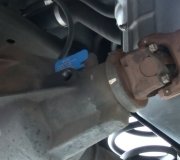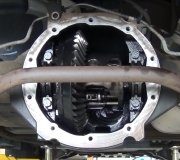Hey I also found this bulletin about a whining from the rear end see if that sound's like what your hearing.
Bulletin No: 03-04-17-002A
Date: December 06, 2006
TECHNICAL
Subject:
Whine Noise From Rear Axle (Diagnose and Replace Rear Propeller Shaft With New Tuned Torsional Damper Rear Propeller Shaft)
Models:
2004-2007 Buick Rainier
2002-2007 Chevrolet TrailBlazer
2002-2007 GMC Envoy
2002-2004 Oldsmobile Bravada
with 4.2L 6-Cylinder Engine (VIN S - RPO LL8), 4.10 Ratio Rear Axle (RPO GT5) and Standard (Short) Wheelbase
Supercede:
This bulletin is being revised to add model years and update the models affected. Please discard Corporate Bulletin Number 03-04-17-002 (Section 04 - Driveline/Axle).
Condition
Some customers may comment on a slight axle whine heard only on deceleration or coast conditions. The noise peaks at about 77 to 83 km/h (48 to 52 mph) before quieting at about 72 km/h (45 mph).
Cause
"Inherent" ring and pinion gear whine.
All gear driven units, such as automotive rear axles, produce some level of noise that cannot be eliminated with conventional adjustments and repairs. "Inherent" axle noise can be described as a slight noise heard only at a certain speed (typically between 72-96 km/h (45-60 mph). The presence of this noise is not indicative of a functional concern with the axle assembly. However, some customers may find that this "inherent" axle noise is unacceptable.
Correction
If the noise is not correctly diagnosed as "inherent" and having a peak in the narrow speed range of 77 to 83 km/h (48 to 52 mph) on deceleration or coast conditions, the addition of a tuned torsional damper propeller shaft can aggravate the perceptible noise level. It is extremely important to first diagnose the rear axle noise as "inherent" before installing a new tuned torsional damper propeller shaft. Refer to the applicable diagnostic information in the Rear Drive Axle subsection of Service Information.
The new service propeller shafts are only designed to correct the noise condition described above. They will not be effective if repair attempts are made to correct other noise conditions. If propeller shaft replacement is needed for any other reason, the existing service part number propeller shaft should be used.
Replace the rear propeller shaft with a new tuned torsional damper propeller shaft using the applicable part number listed below. The new propeller shaft incorporates a damper assembly to lessen noise transmitted from the rear axle assembly. The new propeller shaft should be used ONLY after diagnosis concludes that it is an "inherent" rear axle noise and no physical damage or incorrect adjustment exists. Refer to the Propeller Shaft subsection of Service Information (SI) for rear propeller shaft replacement procedures.
Monday, March 7th, 2011 AT 8:51 PM






